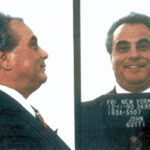We conclude our exploration into the wisdom of Rev. Adam Hamilton’s “Revival: Faith as Wesley Lived It,” pausing, much like St. Francis in Caravaggio’s depiction, in contemplation. This journey through Rev. Hamilton’s insights has been enriching, and for those who have followed this series, thank you. For newcomers, or those who may have missed previous reflections, links to earlier installments are provided below.
Rev. Hamilton’s concluding chapter is indeed powerful, highlighting Wesley’s unwavering perseverance amidst opposition, his later teachings on wealth and his staunch stance against slavery—including the stirring account of a sermon that ignited a physical altercation among British Methodists. Finally, we encounter Wesley’s inspiring and peaceful death.
However, this final reflection will center on a particularly striking aspect of Wesley’s ministry: the controversy and opposition sparked by his commitment to outdoor preaching. Yes, the often-misunderstood practice of street preaching. It is suggested here that Wesley’s approach embodies something fundamental to the spirit of Methodism, and indeed Christianity itself. The widespread neglect of this form of witness might be considered a contributing factor to contemporary spiritual decline.
Let’s examine Rev. Hamilton’s portrayal of John Wesley Preaching:
“Because of Wesley’s challenging style and message, many churches were closed to him, so he began preaching in the fields and marketplaces, often quite near the churches that had shut their doors to him. As we’ve learned, most towns with a market had a market cross at the center as a visible reminder to merchants that Christ watched as they conducted business. Wesley often preached on the stairs or near these crosses. He would start by singing hymns until a crowd had gathered, then he would begin to preach about the need for salvation, forgiveness, and waking to God” (125).
This became Wesley’s regular practice, almost daily for two decades. During this time, crowds were frequently hostile. Offended Anglican clergy sometimes even employed thugs to disrupt Wesley’s sermons (125).
Wesley endured physical assaults, arrests by magistrates, and was often “pelted with rotten tomatoes, manure, and stones” (126).
Yet, he remained steadfast.
And within every gathering, some were deeply moved by his message (126).
Based on Hamilton’s account, the core elements of John Wesley preaching in the streets were:
- Initiate by singing hymns in a public space.
- Once a crowd gathers, commence preaching about the necessity of “salvation, forgiveness, and walking with God.”
- If confronted with hostility, persevere and remain undeterred.
- Repeat this process, never relenting.
While personal attempts at street preaching might be fraught with hesitation and humor, John Wesley embraced it fully.
Is this form of ministry relevant or even necessary today?
Absolutely. It was central to Wesley’s ministry, echoing the practices of Jesus Christ, Saint Paul, Saint Peter, Saint Francis, and many others throughout Christian history. The Gospel provides Christians with a vital message, one of profound importance, and many are called to share this message publicly.
But isn’t Christian witness primarily about actions, not just words?
There’s a common saying attributed to St. Francis: “Preach the gospel everywhere you go, and if necessary, use words.” It’s often used to justify a preference for living out the gospel through actions, implying that our lives alone should eloquently communicate Christ’s message.
While St. Francis’ life indeed powerfully reflected Christ, even he, and certainly we, recognize the gap between our lives and Christ’s holiness. St. Francis bridged this gap with words. His words were not delivered from a position of superiority, but from humility. As the founder of a penitential order, Francis’ call to repentance was rooted in his own acknowledgment of being a sinner before God. Therefore, a faithful interpretation of “Preach the gospel everywhere you go, and if necessary, use words,” suggests that recognizing our own imperfections, we must use words to articulate our need for God’s mercy and bear witness to Christ’s saving grace.
Effective street preaching, like John Wesley preaching, is characterized by humble clarity: a forgiven sinner testifying to the immense mercy of Jesus Christ, a holiness profoundly evident in his compassion for sinners.
Where can this be practiced in contemporary society?
For many, the digital realm, particularly platforms like YouTube, offers an accessible “public square.” While perhaps less daunting than physical street preaching, it’s a valid avenue for public witness. Every Christian, especially those in ministry, could consider creating brief, impactful testimonies with a call to conversion, easily shared in email signatures or online platforms.
Beyond the digital space, numerous physical opportunities exist. Universities often have free speech zones. Marketplaces, shopping malls (preaching peacefully and leaving when requested), and even organized flash mobs can become platforms for sharing a personal testimony of faith and the transformative power of God’s mercy in Jesus Christ. Drawing inspiration from Catholic street evangelization efforts can also provide valuable models for engaging in public witness. The possibilities are limited only by imagination, courage, and humility.
Can you provide a contemporary example of this in action?
Consider the ministry of pastor and apologist Cliffe Knechtle. His approach, as recounted, involved going to bars during his seminary days. He and his friends would initiate conversations, and then Knechtle would deliver a concise gospel presentation. Though often asked to leave, his friends could then continue conversations sparked by his bold witness, engaging those who had just heard the gospel in further dialogue.
To truly embrace the legacy of John Wesley preaching, and the call of the Gospel, requires venturing into the public sphere in diverse ways, even embracing the perceived challenge of street preaching. It means openly acknowledging our imperfections while inviting others to encounter Jesus Christ.
It is in both embodying and proclaiming this message of sin and redemption that we reflect the boundless mercy that underpins all of creation.
+++
Adam Hamilton’s “Revival”-inspired posts: A recap.
#1 Susanna Wesley, Adam Hamilton and our kids
#4 Wesley’s impolite enthusiasm for the Name
#5 Wesley’s both/and Scripture way of salvation
Thanks Rev. Hamilton for writing the book!
Christ’s peace to all.

